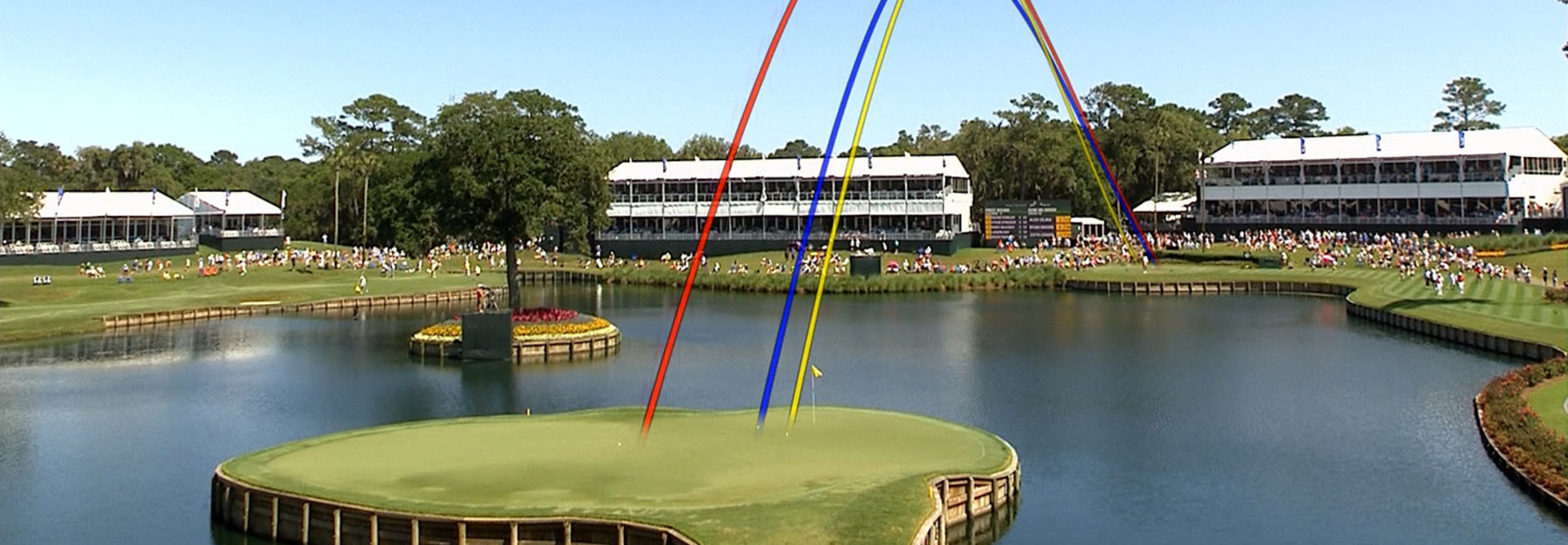How TV Producers Use Technology to Cover the “Island Green”
It takes a lot of technology to tell the story of 137 yards.
To be precise, it takes nine cameras (including one stationed on a crane and one that travels along a suspended cable), dozens of microphones, a telestrator that allows announcers to draw on the screen, a Protracer system that tracks the flight of the golf ball and tools to zoom in on shots and show replays in super slow motion.
Those are the tools that Tommy Roy, the producer of NBC and Golf Channel’s PGA Tour coverage, has on hand to cover just one hole at this week’s Players Championship: the infamous par-3 17th at TPC Sawgrass that features the “island green”).
“This is really the only hole on the entire PGA Tour where players — they’re grinding when they get on that tee,” Roy says. “Under normal circumstances, they’d hit that green every time, but because it’s surrounded by water, there’s a lot of drama. We have to have all angles of it covered.”
In addition to the advanced camera technology, the PGA Tour makes use of its ShotLink System, which is powered by the PGA Tour’s technology partner CDW, to capture and disseminate scoring and statistical data in real time and support broadcast coverage of the Players Championship.
The 17th hole on the Players Stadium Course at TPC Sawgrass — a Ponte Vedra Beach, Fla., course designed specifically to host this tournament — became one of the most iconic holes in golf by accident. Course designers originally planned to place only a small pond near the green, but crews kept digging to harvest the sand. Eventually, the green was almost totally surrounded by a crater. Today, that crater is a lake, and just a narrow walkway connects the green to the rest of the course.
All that water — along with the hole’s placement near the end of the course — can create immense psychological pressure for players. Each year spectators see dozens of balls find their way into the lake instead of onto the green, and Roy captures the sight and sound of each splash with strategically placed cameras and microphones.
The slow-motion replay system gets a lot of use on this hole, as well, as it allows Roy to show each player’s eyes at the precise moment he realizes whether his ball will end up in the drink or near the hole.
“We see all kinds of emotions there,” Roy says. “It makes for really good television.”
The Legacy of the 17th Hole
The island green has been the site of some of the most dramatic and memorable moments in recent golf history. In 2001, Tiger Woods putted from the fringe, 60 feet out, raising his club in the air as the ball broke first to the left and then to the right. Announcer Gary Koch twice called the putt “better than most” as the ball traveled along its path, and then he exclaimed the phrase once more as the ball found the cup, giving Woods the lead — and ultimately, the victory.
In 1999, Fred Couples made one of the most famous pars ever when, after his first shot went into the water, he hit his second tee shot directly into the hole – without so much as a bounce. And in 1998, Steve Lowery safely found the green on his first shot, but then a seagull picked the ball up in its beak, flew off and dropped it in the lake.
Roy calls the Players Championship, which is sometimes referred to as the “fifth major” due to its prestige and large purse, “the crown jewel” of the PGA Tour. “The majors are run by other organizations,” he says. “This is the biggest event that the PGA Tour runs. In an event of this magnitude, we want to bring the viewer the very best that we can, and technology is a big part of that.”
Because golf moves more slowly than other sports, Roy strives to constantly give viewers new content — whether that means showing B-roll of swooping beauty shots taken in prior years by cameras mounted on drones, displaying an interesting graphic or pausing and zooming in on a golfer’s grip during a swing replay.
“In today’s age of short attention spans, you’ve got to have something happening all the time on the screen,” Roy says. “You can’t just sit around and watch guys line up putts.”
This year, Roy hopes to try something new, providing a Protracer side view of shots on the 17th hole, instead of only a view from behind. He says a side view will better show how high or low the ball is hit, which is crucial information in determining how likely it is to end up in the water.
As always, Roy’s telecast will follow the leaders of the tournament. But when the leaders aren’t hitting, he knows which nine cameras he’s likely to turn to most often.
“When you don’t have anywhere to go, you go to 17,” he says. “Even if the guy’s in dead last place, it’s fun to watch.”









